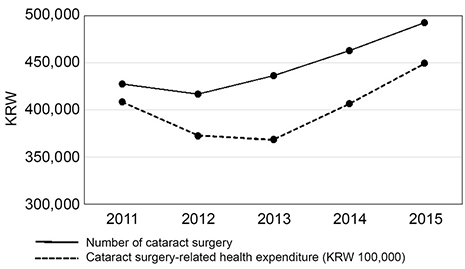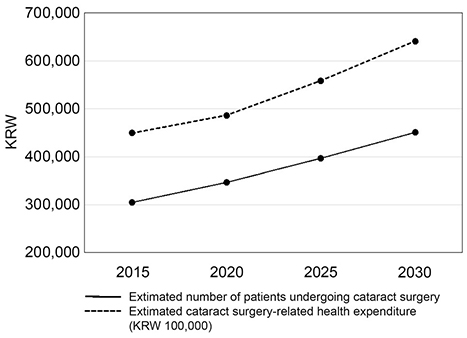J Korean Ophthalmol Soc.
2019 Sep;60(9):829-834. 10.3341/jkos.2019.60.9.829.
Estimated Incidence and Cost Projections of Cataract Surgery in the Republic of Korea
- Affiliations
-
- 1Department of Ophthalmology, National Health Insurance Service Ilsan Hospital, Goyang, Korea. eunjee95@nhimc.or.kr
- 2Department of Policy Research Affairs, National Health Insurance Service Ilsan Hospital, Goyang, Korea.
- KMID: 2459126
- DOI: http://doi.org/10.3341/jkos.2019.60.9.829
Abstract
- PURPOSE
We sought to predict the future incidence and health expenditures of cataract surgery in the Republic of Korea.
METHODS
From 2011 to 2015, National Health Insurance claims data were used to estimate the incidence and prevalence changes of cataract surgery according to demographic characteristics (year, sex, residence, and age). Based on the above results and changes in future population distribution, we estimated the incidence of cataract surgery by 2030. Considering the cost of cataract surgery from 2011 to 2015, we also predicted future health expenditures for cataract surgery.
RESULTS
A total of 2,236,107 eyes of 1,591,176 patients underwent cataract surgery from 2011 to 2015. The total number of operated eyes per year increased, from 427,729 to 492,700 (+15%), and the number of patients increased from 306,710 to 346,056 (+12%) from 2011 to 2015. The cost of cataract surgery reimbursed by the National Health Insurance Service (NHIS) increased from 408,307,530,900 won ($360 million) to 449,334,367,080 won ($399 million) (+9%). The future prevalence of cataract surgery was predicted to reach 562,003 in 2030 from 346,056 in 2015. The cost of cataract surgery is expected to increase from 449 billion won ($399 million) in 2015 to 641 billion won ($570 million) in 2030.
CONCLUSIONS
Cataract surgery and medical expenses will increase due to social aging. Therefore, we need policies to secure medical resources and expand insurance indications.
Keyword
MeSH Terms
Figure
Reference
-
1. Daien V, Le Pape A, Heve D, et al. Incidence and characteristics of cataract surgery in France from 2009 to 2012: a national population study. Ophthalmology. 2015; 122:1633–1638.2. Hyman L. Epidemiology of eye disease in the elderly. Eye (Lond). 1987; 1(Pt 2):330–341.
Article3. Klein BE, Klein R, Moss SE. Incident cataract surgery: the Beaver Dam eye study. Ophthalmology. 1997; 104:573–580.4. Panchapakesan J, Mitchell P, Tumuluri K, et al. Five year incidence of cataract surgery: the Blue Mountains Eye Study. Br J Ophthalmol. 2003; 87:168–172.
Article5. Vision Problems in the U.S. Prevalence of Adult Vision Impairment and Age- Related Eye Disease in America. Chicago: Prevent Blindness America;2008.6. Congdon N, Vingerling JR, Klein BE, et al. Prevalence of cataract and pseudophakia/aphakia among adults in the United States. Arch Ophthalmol. 2004; 122:487–494.7. National Health Insurance Service. Main Surgery Statistical Yearbook 2015. 1st ed. Wonju: National Health Insurance Service;2015. p. 1–531.8. Statistics Korea. Population projections for Korea: 2015–2065 (based on the 2015 Census). 1st ed. Daejeon: Statistics Korea;2017. p. 353.9. Hyun KR, Kang S, Lee S. Population aging and healthcare expenditure in Korea. Health Econ. 2016; 25:1239–1251.
Article10. Behndig A, Montan P, Stenevi U, et al. One million cataract surgeries: Swedish National Cataract Register 1992–2009. J Cataract Refract Surg. 2011; 37:1539–1545.
Article11. Gollogly HE, Hodge DO, St Sauver JL, Erie JC. Increasing incidence of cataract surgery: population-based study. J Cataract Refract Surg. 2013; 39:1383–1389.
Article12. Lansingh VC, Carter MJ, Martens M. Global cost-effectiveness of cataract surgery. Ophthalmology. 2007; 114:1670–1678.
Article13. Etzioni DA, Liu JH, Maggard MA, Ko CY. The aging population and its impact on the surgery workforce. Ann Surg. 2003; 238:170–177.
Article14. Rochtchina E, Mukesh BN, Wang JJ, et al. Projected prevalence of age-related cataract and cataract surgery in Australia fro the years 2001 and 2021: pooled data from two population-based surveys. Clin Exp Ophthalmol. 2003; 31:233–236.15. Hatch WV, Campbell Ede L, Bell CM, et al. Projecting the growth of cataract surgery during the next 25 years. Arch Ophthalmol. 2012; 130:1479–1481.
Article
- Full Text Links
- Actions
-
Cited
- CITED
-
- Close
- Share
- Similar articles
-
- An epidemic of cataract surgery in Korea: the effects of private health insurance on the National Health Insurance Service
- The Complications of Cataract Extraction
- The Evaluation of Incidence of Hyphema as Early Complication following Sutureless Cataract Surgery
- Incidence and Direct Medical Cost of Adjustment Disorder and in Korea Using National Health Insurance Service Claims Data From 2011 to 2017
- Cost-Effectiveness Analysis of Cataract Surgery for the Beginners Using Intraocular Illumination



